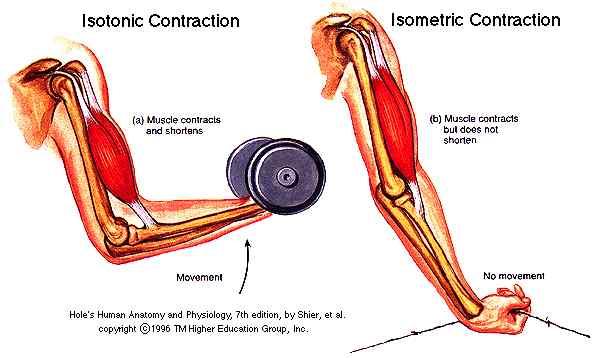Topic: Mechanism of muscle contraction.
Question: Write briefly on 1) isometric versus isotonic contractions 2) fast versus slow muscle fibers.
Click here for Reference Material-This material is informational alone and is not specifically prepared as an answer for any question. Readers may do their own research before finalising diagnoses according to the characteristics unique to each question. Readers should not proceed without cross-referencing with relevant textbooks as well as standard guidelines available.
Here is a brief overview of isometric vs isotonic contractions and fast vs slow muscle fibers:

1. Isometric vs Isotonic Contractions:
•Isometric contractions: Muscle fibers contract but do not change length. They generate tension without movement. For example, pushing against a wall. Isometric exercise helps build strength at a specific joint angle.
•Isotonic contractions: Muscle fibers contract and change length, generating movement. For example, bicep curls or squats. Isotonic exercise promotes strength and flexibility gains over a range of motion.

2. Fast vs Slow Muscle Fibers:
•Fast muscle fibers (Type II): Contract quickly and powerfully but fatigue rapidly. Used for short bursts of speed or strength. Fast fibers rely on anaerobic metabolism to produce ATP without oxygen.
•Slow muscle fibers (Type I): Contract slowly but are fatigue-resistant. Used for endurance activities. Slow fibers use aerobic metabolism and oxygen to produce ATP.
•Most muscles contain a mix of fast and slow fibers. The proportion of fiber types depends on a muscle’s function. Fast-twitch muscles like the gastrocnemius (calf) contain more fast fibers. Slow-twitch muscles like the soleus contain more slow fibers.
•Exercise can stimulate transitions between fast and slow fibers over time. Endurance training increases slow fibers, while strength/power training increases fast fibers. This fiber type conversion contributes to improved performance.
•Fiber type is determined genetically but can be influenced by physical activity levels and training. Non-exercising muscles atrophy and show a loss of fast muscle fibers with aging. Exercise helps preserve muscle fiber size, number and type.
In summary, isometric contractions generate tension while isotonic contractions produce movement. Fast muscle fibers provide speed and power but fatigue quickly, while slow fibers are endurance-focused. A balance of fast and slow fibers, influenced by both genetics and training, allows for optimal muscle performance. Exercise impacts fiber type conversion and helps reduce age-related fiber atrophy and loss.








